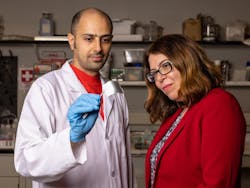R&D Spotlight: Stretchable, Flexible Li-Ion Batteries are a Natural Fit for Wearables
A team of researchers at the University of Houston has designed and developed a prototype of a fully stretchable fabric-based lithium-ion battery.
The breakthrough lies in the use of conductive silver fabric as a platform and current collector, according to the paper published in Extreme Mechanics Letters.
The cutting-edge design of the lithium-ion battery is the brainchild of Haleh Ardebili, Bill D. Cook Professor of Mechanical Engineering at UH.
In prior work Ardebili’s team successfully presented a proof-of-concept that rendered just the cathode to be stretchable. This research builds on that success by presenting the design, fabrication and characterization of the fully stretchable fabric-based lithium-ion battery.
“It seemed a natural next step to create and integrate stretchable batteries with stretchable devices and clothing,” noted Ardebili. “Imagine folding or bending or stretching your laptop or phone in your pocket. Or using interactive sensors embedded in our clothes that monitor our health.”
Solid Polymer Electrolyte Fabric-Based Battery
A drawback in the design of wearable batteries has been that they are conventionally rigid. This limits functionality and how devices can be embedded into the devices they power. The researchers also pointed out that those batteries use liquid electrolyte, which is flammable and may catch fire or explode under certain conditions.
In this work, the UH researchers have instead transformed rigid lithium-ion battery electrodes into solid polymer electrolyte wearable, fabric-based, flexible and stretchable electrodes.
“The weaved silver fabric was ideal for this since it mechanically deforms or stretches and still provides electrical conduction pathways necessary for the battery electrode to function well,” explained Ardebili, the corresponding author of a paper. “The battery electrode must allow movement of both electrons and ions.”
Ardebili was interested in understanding the science behind stretching an electrochemical cell and its components. “This was an unexplored field in science and engineering and a great area to investigate,” she said.
The authors stated in a press release that the science of coupling effects of mechanical deformation and electrochemical performance is an important field, and stretchable batteries provide a great vehicle for exploring the fundamental mechanisms.
The stretchable technology opens up the possibilities by offering stable performance and safer properties for wearable devices and implantable biosensors, they said.
There’s More Work to be Done
The battery technology won’t be coming to a supplier near you anytime soon, however, the researchers noted it does have applicability for powering up smart space suits, consumer electronics embedded in garments that monitor people’s health and devices that interact with humans at various levels, according to the researchers.
“Commercial viability depends on many factors such as scaling up the manufacturability of the product, cost and other factors,” Ardebili said in the press note. “We are working toward those considerations and goals as we optimize and enhance our stretchable battery.”
The key is to prove that the product is reliable and safe. “My goal is to make sure the batteries are as safe as possible,” she said.
The first author of the paper is Bahar Moradi Ghadi, a former doctoral student who based her dissertation on this research. Access the paper here: “Stretchable Fabric-Based Lithium-Ion Battery.”
Read More
About the Author

Rehana Begg
Editor-in-Chief, Machine Design
As Machine Design’s content lead, Rehana Begg is tasked with elevating the voice of the design and multi-disciplinary engineer in the face of digital transformation and engineering innovation. Begg has more than 24 years of editorial experience and has spent the past decade in the trenches of industrial manufacturing, focusing on new technologies, manufacturing innovation and business. Her B2B career has taken her from corporate boardrooms to plant floors and underground mining stopes, covering everything from automation & IIoT, robotics, mechanical design and additive manufacturing to plant operations, maintenance, reliability and continuous improvement. Begg holds an MBA, a Master of Journalism degree, and a BA (Hons.) in Political Science. She is committed to lifelong learning and feeds her passion for innovation in publishing, transparent science and clear communication by attending relevant conferences and seminars/workshops.
Follow Rehana Begg via the following social media handles:
X: @rehanabegg
LinkedIn: @rehanabegg and @MachineDesign

